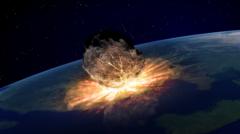With research led by Prof. Nadja Drabon of Harvard University, the team embarked on a challenging expedition to South Africa’s Eastern Barberton Greenstone Belt, where they collected crucial rock samples from the ancient impact site. This meteorite, designated S2, was between 40-60 km in diameter—over 200 times as massive as the infamous asteroid that eradicated the dinosaurs 66 million years ago.
During their three expeditions, the scientists faced risks from wild animals and potential poachers as they hiked into remote mountain areas. Their efforts focused on locating spherule particles, remnants from the impact, providing key insights into this ancient cataclysm.
The analysis confirmed that the S2 crash created a massive 500 km crater, sending molten rock particles spiraling into the atmosphere, leading to a global rain of hot debris. The ensuing tsunami would have dramatically restructured coastlines and drastically raised ocean temperatures, causing massive evaporation and choking sunlight from reaching the planet, thereby threatening simple life forms dependent on photosynthesis.
Surprisingly, the study also revealed that this violent event stirred up essential nutrients, such as phosphorus and iron, from Earth's depths, which likely enriched the early oceans, fostering resilience and rapid recovery in microbial life. Prof. Drabon likened this dynamic to how bacteria quickly repopulate after a disruption.
This research adds to a growing understanding that, despite initial devastation, such impacts may have unintentionally created conditions conducive for early life to flourish. The findings are detailed in the scientific journal PNAS, providing new insights into how life's resilience shaped Earth's early atmosphere and ecosystems amid astronomical chaos.
During their three expeditions, the scientists faced risks from wild animals and potential poachers as they hiked into remote mountain areas. Their efforts focused on locating spherule particles, remnants from the impact, providing key insights into this ancient cataclysm.
The analysis confirmed that the S2 crash created a massive 500 km crater, sending molten rock particles spiraling into the atmosphere, leading to a global rain of hot debris. The ensuing tsunami would have dramatically restructured coastlines and drastically raised ocean temperatures, causing massive evaporation and choking sunlight from reaching the planet, thereby threatening simple life forms dependent on photosynthesis.
Surprisingly, the study also revealed that this violent event stirred up essential nutrients, such as phosphorus and iron, from Earth's depths, which likely enriched the early oceans, fostering resilience and rapid recovery in microbial life. Prof. Drabon likened this dynamic to how bacteria quickly repopulate after a disruption.
This research adds to a growing understanding that, despite initial devastation, such impacts may have unintentionally created conditions conducive for early life to flourish. The findings are detailed in the scientific journal PNAS, providing new insights into how life's resilience shaped Earth's early atmosphere and ecosystems amid astronomical chaos.

















